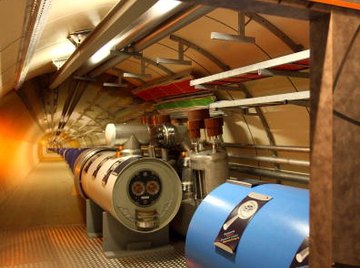To embark on a journey through the microcosm of particle physics, one must first understand the fundamental building blocks of matter. Within this quantum universe, atoms constitute the quintessential elements of existence, comprised primarily of protons, neutrons, and electrons. However, the intrigue deepens when we delve into the realm of subatomic particles—those enigmatic entities that dwell in the shadows of the atomic structure. A pertinent question arises: are there any particles smaller than an atom that possess mass?
In the grand theater of particle physics, we must first consider the constituents of an atom. Protons and neutrons, collectively housed in the nucleus, are themselves not atomic in the strictest sense. They are, in fact, composite particles made up of even smaller entities known as quarks, which are bound together by the strong force mediated by gluons. This revelation leads us down a fascinating yet complex rabbit hole, as we confront the intriguing notion of whether any subatomic particles could exist beyond this already diminutive scale while still retaining mass.
Quarks are often described as point-like particles, possessing fractional electric charges and forming the core of baryons and mesons—the two families of particles that embody protons and neutrons. Each quark type, or “flavor,” comes in six varieties: up, down, charm, strange, top, and bottom. While quarks themselves do contribute to the overall mass of an atom, they exist in a perpetual state of absence, never residing in isolation due to a phenomenon known as confinement. Hence, one might ask if there exist any even smaller entities that escape such confinement and possess mass.
The search for particles smaller than quarks leads us to the realm of leptons, another class of fundamental particles. Electrons, muons, and tau particles are all examples of leptons, with neutrinos being the most elusive among them. Although electrons are a critical component of atoms, other leptons beg the question of their mass properties. The neutrino, in its ethereal existence, is renowned for its minuscule mass, so small that it was once considered to be nearly massless. However, current research has established that neutrinos possess a tiny but finite mass, yet they remain elusive in the depths of their interactions.
Moreover, the mystery continues with the concept of the Higgs boson, an elementary particle that manifests as a carrier of the Higgs field. This field endows other particles with mass through the Higgs mechanism, which plays a pivotal role in demystifying the origin of mass itself. While the Higgs boson is not smaller than an atom in a conventional sense, its discovery adds a layer of complexity to our understanding of mass at subatomic scales. In this light, particles such as the Higgs boson are not merely the end of the road but rather an entry point into a more profound exploration of mass and its relations.
The question of mass raises a critical distinction between massless particles, such as photons, which travel at light speed, and those with mass that can be quantified, albeit in minimal terms. Practically all known elementary particles verify the principle that mass is quintessential to matter, as it conveys a sense of inertia and imparts influence in various interactions within the universe. Consequently, within the labyrinthine structure of particle categories, the answer emerges with clarity: while quarks and leptons dominate the subatomic domain, indeed, there are entities smaller than atoms that possess mass, even if it is minuscule.
Conceptually, one could liken this exploration of subatomic particles to peeling the layers of an intricate onion. With each layer revealed, one might encounter a jarring truth: particles can exist sub-atomically where the synergy of forces and energies interplays. Mass, though elusive in some cases, persists as a characteristic of entities inhabiting this quantum landscape. As we probe these depths further, the implications extend far beyond simple mass values, entwining with the fabric of cosmology itself.
Moreover, the ongoing advancements in quantum physics tools such as Large Hadron Colliders provide astrophysicists new avenues to probe the boundaries of the known universe. This meticulous experimentation may yet unveil additional particles that reside below the thresholds of contemporary particle theory, hence expanding our comprehension of mass and its applications across various scientific paradigms—from theoretical physics to practical engineering.
As the narrative surrounding particles smaller than atoms unfolds, it becomes evident that the inquiry transcends mere determinism. The world of subatomic physics showcases a paradox, a ballet of mass and energy that defines our universe’s very structure. Each particle, whether quark, lepton, or boson, weaves into the larger tapestry of existence, revealing interconnections that defy our more conventional predilections.
Ultimately, while the quest to isolate increasingly smaller particles may lead to tantalizing discoveries, it also serves as a profound reminder of the intricate and complex relationship between mass and existence itself. In essence, we may grasp only fleeting glimpses into the beautifully chaotic spirit of the cosmos—where particles smaller than atoms, carrying even the tiniest semblance of mass, remind us of our perpetual quest for understanding the fundamental nature of reality.












